Intel Haswell-EP Xeon 14 Core Review: E5-2695 V3 and E5-2697 V3
by Ian Cutress on November 20, 2014 10:00 AM ESTProfessional Performance: Windows
Agisoft Photoscan – 2D to 3D Image Manipulation: link
Agisoft Photoscan creates 3D models from 2D images, a process which is very computationally expensive. The algorithm is split into four distinct phases, and different phases of the model reconstruction require either fast memory, fast IPC, more cores, or even OpenCL compute devices to hand. Agisoft supplied us with a special version of the software to script the process, where we take 50 images of a stately home and convert it into a medium quality model. This benchmark typically takes around 15-20 minutes on a high end PC on the CPU alone, with GPUs reducing the time.
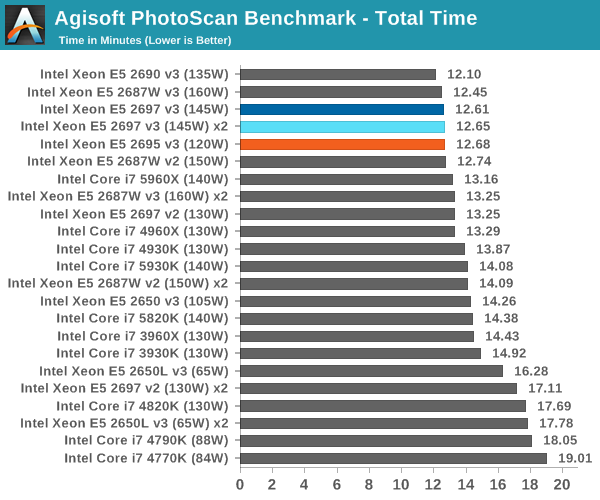
Cinebench R15
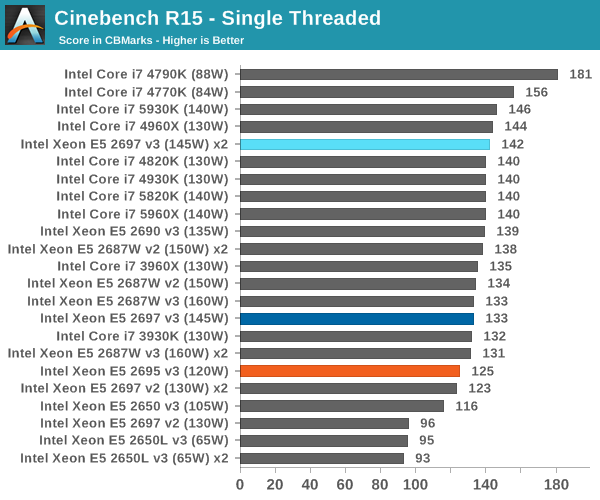
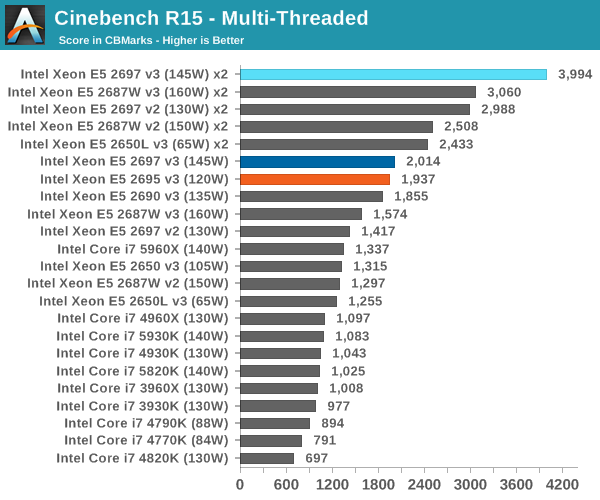
Professional Performance: Linux
Built around several freely available benchmarks for Linux, Linux-Bench is a project spearheaded by Patrick at ServeTheHome to streamline about a dozen of these tests in a single neat package run via a set of three commands using an Ubuntu 14.04 LiveCD. These tests include fluid dynamics used by NASA, ray-tracing, molecular modeling, and a scalable data structure server for web deployments. We run Linux-Bench and have chosen to report a select few of the tests that rely on CPU and DRAM speed.
C-Ray: link
C-Ray is a simple ray-tracing program that focuses almost exclusively on processor performance rather than DRAM access. The test in Linux-Bench renders a heavy complex scene offering a large scalable scenario.
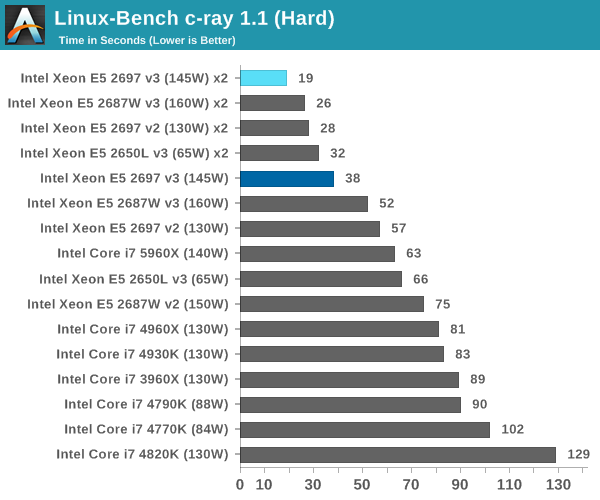
NAMD, Scalable Molecular Dynamics: link
Developed by the Theoretical and Computational Biophysics Group at the University of Illinois at Urbana-Champaign, NAMD is a set of parallel molecular dynamics codes for extreme parallelization up to and beyond 200,000 cores. The reference paper detailing NAMD has over 4000 citations, and our testing runs a small simulation where the calculation steps per unit time is the output vector.
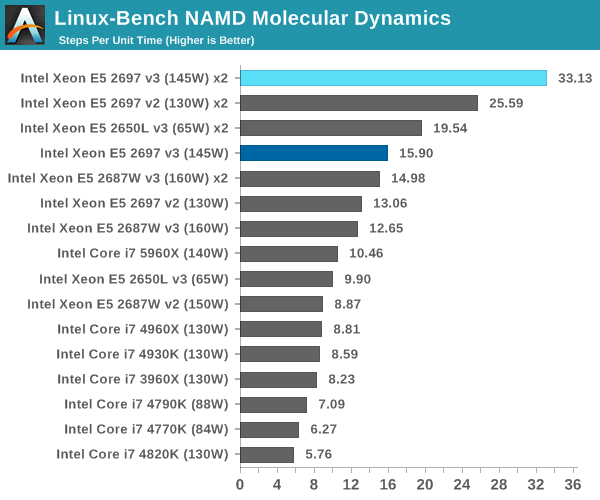
NPB, Fluid Dynamics: link
Aside from LINPACK, there are many other ways to benchmark supercomputers in terms of how effective they are for various types of mathematical processes. The NAS Parallel Benchmarks (NPB) are a set of small programs originally designed for NASA to test their supercomputers in terms of fluid dynamics simulations, useful for airflow reactions and design.
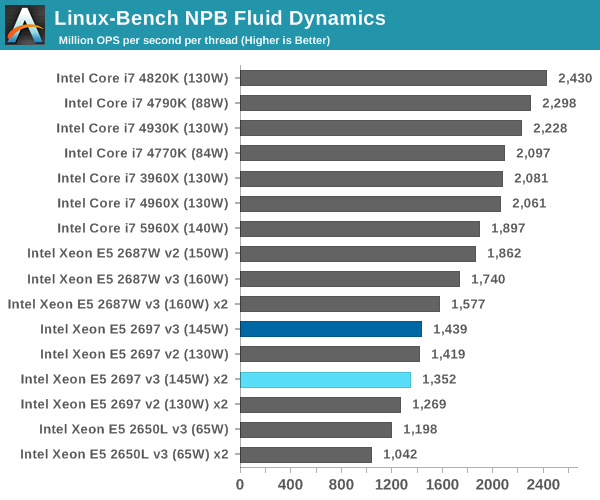
Redis: link
Many of the online applications rely on key-value caches and data structure servers to operate. Redis is an open-source, scalable web technology with a strong developer base, but also relies heavily on memory bandwidth.
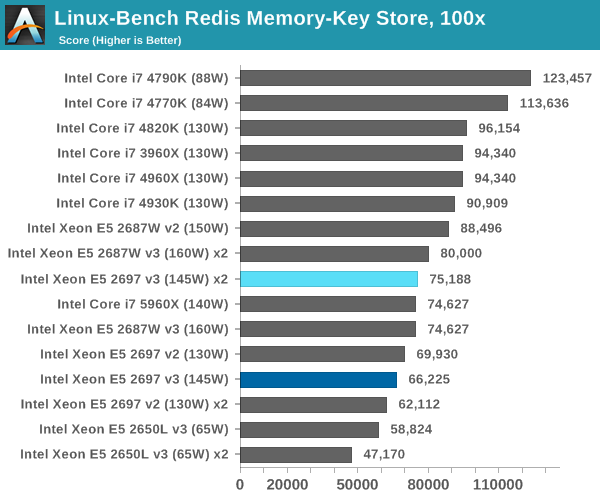
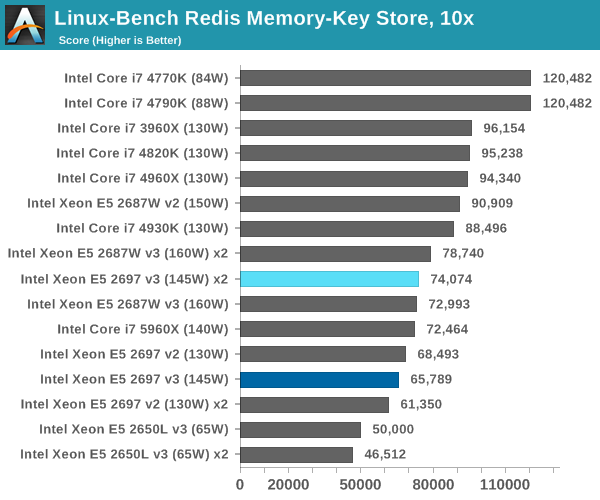
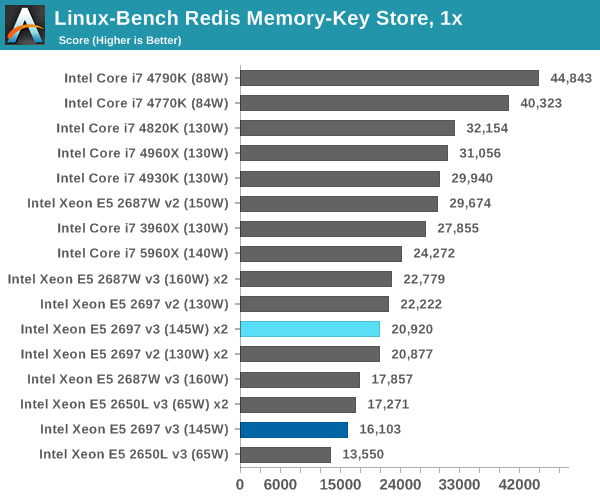










44 Comments
View All Comments
bill.rookard - Thursday, November 20, 2014 - link
I don't think I'd want one. If you notice, a majority of the benchmarks which a normal person might find useful the i7-4790K came in highest and flat out won 12 of those benchmark tests. And of course it costs about 1/10th the price.MrSpadge - Thursday, November 20, 2014 - link
Since he's reading AT I don't think he's a normal "person" ;)dgingeri - Thursday, November 20, 2014 - link
you're right about that. I'm a systems admin in a test lab. I'd want it for my VM practice system. A Core i7 3930k isn't quite as nice to run a dozen VMs as I had hoped.cjcoats - Thursday, November 20, 2014 - link
About those Linux benchmarks:1) That "NPB, Fluid Dynamics" reports millions of operations _per thread_, which is deceptive as regards actual delivered "in your face" work performed per wall-clock time; the existing chart should be supplemented by one giving [ops per thread per sec]*[number of threads] -- i.e., total ops per sec, which is what I really care about.
2) For Linux benchmarks in general: what compiler and compile-flags? ...and is this "one binary for all the machines"? The performance can be greatly influenced by targeting the actual processor architecture ("-xHost" for Intel compilers, "-march=native -mtune=native" for Gnu. For the codes I use and the (SandyBridge or later) servers I use, targeting the architecture I'm running on typically may give as much as a 70% boost, which is nothing to sneer at when my run-times are measured in hours or even days.
mapesdhs - Friday, November 21, 2014 - link
Re your 2nd point, that's certainly true for th C-ray test. One can do all sorts of optimisationsto show huge performance gains which are not remotely realistic. Wouldn't surprise me if this
affects the other tests too.
Ian.
FriendlyUser - Thursday, November 20, 2014 - link
Will it play Assassin's Creed: Unity?anubis44 - Thursday, November 20, 2014 - link
You forgot to say: "BUT can it run (insert terribly optimized pig-of-a-game here) ?"Cravenmor - Thursday, November 20, 2014 - link
Enjoying my coffee...Laststop311 - Thursday, November 20, 2014 - link
These xeons are just crazy priced. I would be happy with an i7-5960k clocked at 4.2ghz to match my i7-980x clocked at 4.2ghz. But really even after 4 years the performance increase still does not justify spending close to 2000 on cpu + x99 mobo + 4x8GB ddr4. Since broadwell is just a tick broadwell-e probably wont justify the expense either so maybe after 6 years have passed with gulftown skylake-e will finally make the expense worth it. Even if not the extra features like pci-e connected storage, ddr4 and pci-e 4.0 will finally make it worth it. By then the ridiculous ddr4 ram prices should be in line with how ddr3 is priced now too.wallysb01 - Thursday, November 20, 2014 - link
You must not be doing much heavily threaded work then, because for those that are the total system performance delivered with say, a $7K workstation, has gone through the roof compared to westmere.For example, the X5660 was 6 cores at 2.8GHz and the E5-2650v3 is 10 cores at 2.3GHz, but actually operates at 2.5GHz (something westmere didn’t do with the difference in turbo binning), both for a little over $1000 bucks each. Then, if we add 5% performance per generation, that brings the 2.5GHz to 2.9 “westmere equivalent” GHz. Then the 10 core vs 6 core means the E5-2650v3 is giving you 70% more performance than the X5660 did.